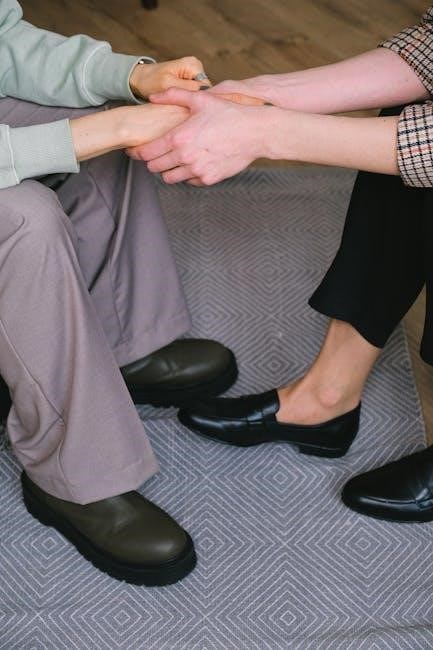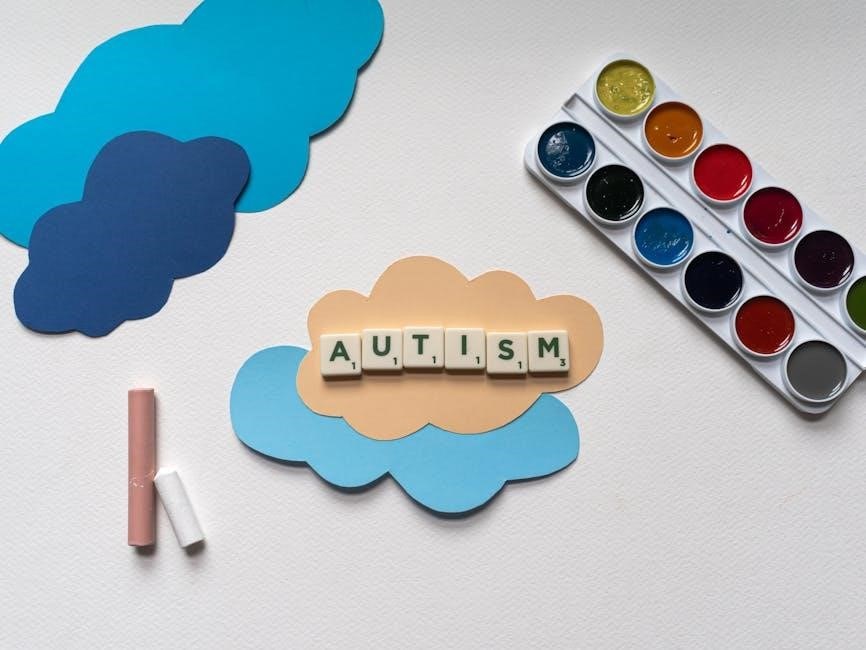School-Based Occupational Therapy (SBOT) focuses on enabling students to participate in daily school activities, supporting their academic achievement and positive behaviors through meaningful occupations.
1.1 Definition and Scope of SBOT
School-Based Occupational Therapy (SBOT) involves occupational therapists (OTs) and assistants (OTAs) using meaningful activities to support students’ participation in school. It focuses on enabling students to fulfill their role as learners by addressing skills like self-regulation, posture, and tool use. SBOT promotes academic achievement and positive behaviors, embedding movement and sensory strategies to enhance engagement. It operates within educational settings, collaborating with educators to create inclusive environments.
1.2 Importance of SBOT in Educational Settings
School-Based Occupational Therapy (SBOT) is crucial for fostering inclusive educational environments, enhancing students’ ability to engage in learning. It bridges academic and therapeutic needs, ensuring students can participate fully. By addressing skills like self-regulation and sensory integration, SBOT supports positive behaviors and academic success. Collaboration with educators ensures interventions align with educational goals, making SBOT vital for student well-being and educational outcomes.
1.3 Historical Development of SBOT
School-Based Occupational Therapy (SBOT) has evolved significantly since its inception in the early 20th century. Initially focused on traditional clinical settings, OT transitioned into schools to address students’ needs. The 1970s saw increased recognition of SBOT, with legislation supporting its integration into education. Over time, SBOT has adapted to educational priorities, emphasizing collaboration and evidence-based practices. Its growth reflects a global shift toward inclusive, student-centered approaches.

Roles and Responsibilities of Occupational Therapists in Schools
Occupational therapists in schools support students’ participation in daily activities, collaborate with educators and healthcare professionals, and use meaningful activities to enhance academic achievement and positive behaviors.
2.1 Occupational Therapists (OTs) and Occupational Therapy Assistants (OTAs)
Occupational therapists (OTs) and occupational therapy assistants (OTAs) collaborate to support students’ participation in school activities. OTs assess needs, develop plans, and oversee interventions, while OTAs, under OT supervision, implement strategies to enhance academic and functional skills, ensuring students can engage meaningfully in their educational environment.
2.2 Supporting Students’ Participation in Daily School Activities
School-based occupational therapy (SBOT) focuses on enabling students to engage in daily school activities by addressing specific skills like seated posture, grasp, and self-regulation. OTs embed movement and sensory strategies to help students maintain focus and participate fully, ensuring they can access and benefit from educational opportunities effectively.
2.3 Promoting Academic Achievement and Positive Behaviors
School-based occupational therapy (SBOT) plays a crucial role in promoting academic achievement and positive behaviors by helping students develop necessary skills for learning. OTs use meaningful activities and strategies to support emotional regulation and focus, fostering a conducive environment for success. Collaboration with educators ensures tailored interventions that address individual needs, enhancing overall educational outcomes.

Assessments and Interventions in SBOT
SBOT assessments focus on specific skills like posture, grasp, and self-regulation, while interventions use movement and sensory strategies to support participation and academic success in schools.
3.1 Types of Assessments Used in SBOT
School-based occupational therapy assessments focus on specific skills such as seated posture, grasp, and self-regulation. These evaluations observe students’ performance in school settings, often involving collaboration with teachers and healthcare professionals. Assessments may include standardized tools and informal observations to identify areas needing support. The goal is to align interventions with educational priorities, ensuring students can fully participate in daily school activities and achieve academic success.
3.2 Focusing on Specific Skills for School Success

School-based occupational therapy emphasizes specific skills like handwriting, attention, and sensory integration, which are crucial for academic tasks and social interactions. These skills enable students to engage effectively in classroom activities, fostering both learning and personal growth. By addressing these areas, occupational therapists help students build the foundational abilities needed to succeed in their educational environment and beyond.
3.3 Embedding Movement and Sensory Strategies
Occupational therapists embed movement and sensory strategies to help students regulate alertness and focus. These interventions, such as fidget tools or stretching breaks, enhance participation in school activities. By addressing sensory needs, therapists support emotional regulation and academic engagement, creating a more inclusive and responsive learning environment for all students.
Models of Occupational Therapy Practice in Schools
Occupational therapy models in schools adapt to student needs, emphasizing tiered support systems and alignment with educational priorities to enhance participation and learning outcomes effectively.
4.1 Evolution of Practice Models in U.S. Schools
Occupational therapy practice models in U.S. schools have evolved to address changing student needs, emphasizing evidence-based approaches and alignment with educational priorities. These models adapt to diverse settings, ensuring interventions are tailored to support participation and learning. The integration of tiered support systems reflects a shift toward proactive, inclusive strategies, enhancing accessibility and effectiveness for all students.
4.2 Tiered Support Systems (Universal, Focalized, Intense)
Tiered support systems in SBOT include universal, focalized, and intense interventions. Universal supports benefit all students, while focalized strategies target small groups with specific needs. Intense interventions address individualized requirements, ensuring tailored support. This multi-level approach allows occupational therapists to effectively meet diverse student needs, promoting participation and success in educational settings through a proactive and structured framework.
4.3 Aligning with Educational Priorities and Initiatives
School-Based Occupational Therapy (SBOT) aligns with educational priorities by integrating 21st-century skills and knowledge into practice. Practitioners collaborate with educators to support academic achievement, ensuring interventions are inclusive and tailored to student needs. This alignment fosters participation, promotes positive behaviors, and creates supportive learning environments, ultimately contributing to the broader educational mission and student success.

Collaboration and Professional Development
School-Based Occupational Therapy (SBOT) emphasizes collaboration with teachers and healthcare professionals to enhance student support. Practitioners engage in high-quality professional development, reflecting global educational practices and state priorities.
5.1 Working with Teachers and Healthcare Professionals
School-based occupational therapists (OTs) and occupational therapy assistants (OTAs) collaborate closely with teachers and healthcare professionals to support students’ participation in school activities. This teamwork ensures interventions align with educational goals, promoting academic success and positive behaviors. Effective communication and shared strategies enhance the student’s ability to thrive in the educational environment, fostering a holistic approach to their development and inclusion.
5.2 High-Quality Professional Development for SBOT Practitioners
High-quality professional development for SBOT practitioners is essential for staying updated on best practices, educational priorities, and 21st-century skills. These opportunities ensure practitioners can effectively support students’ participation and learning. Professional development often includes collaboration with educators, integration of research, and alignment with state and global educational initiatives, fostering a well-prepared workforce to address diverse student needs in school settings.
5.3 Addressing the Gap in Understanding SBOT Roles
Research highlights a lack of understanding among preservice and inservice teachers regarding the roles of school-based occupational therapists. This gap stems from limited exposure to SBOT during teacher training. Addressing this requires raising awareness through professional development and collaboration, ensuring educators and healthcare professionals understand how OTs support student participation, academic achievement, and positive behaviors in educational settings.
Addressing Mental Health in Schools Through SBOT
School-based occupational therapy addresses mental health by embedding sensory and movement strategies to support emotional regulation, fostering inclusive environments that promote student well-being and participation.
6.1 Public Health Approach to School Mental Health
A public health approach to school mental health emphasizes prevention, early intervention, and universal strategies to promote well-being. SBOT adopts this model, focusing on tiered support systems to address mental health needs across all levels. By integrating occupational therapy into school-wide initiatives, practitioners can enhance students’ emotional regulation, resilience, and participation in educational activities, fostering a supportive and inclusive environment for all learners.
6.2 Using Occupational Therapy to Support Emotional Regulation
Occupational therapy supports emotional regulation by embedding movement and sensory strategies, helping students manage emotions and stay focused. These interventions create a supportive environment, improving students’ ability to participate in learning. By addressing sensory needs and teaching self-regulation techniques, OTs enable students to better navigate emotional challenges, fostering resilience and academic engagement through tailored, evidence-based practices.
6.3 Promoting Inclusive Educational Environments
School-based occupational therapy fosters inclusive educational environments by addressing barriers to participation. OTs use sensory strategies and collaborate with educators to ensure all students can engage fully. This support enhances learning experiences, promoting diversity and equity. By tailoring interventions, OTs help students thrive, making schools more inclusive and supportive for everyone.

Supporting Educational Transitions
Occupational therapists play a key role in facilitating smooth educational transitions by addressing students’ needs and promoting adaptability. They collaborate with educators to ensure successful transitions.
7.1 Role of OTs in Facilitating Smooth Transitions
Occupational therapists (OTs) play a crucial role in facilitating smooth educational transitions by assessing students’ needs and developing strategies to enhance adaptability. They collaborate with educators to create personalized plans, ensuring students can navigate new environments effectively. OTs also embed movement and sensory strategies to support emotional regulation, fostering resilience during transitions and promoting overall educational success.
7.2 Identifying Relevant Terminology and Practices
Understanding key terms like occupational therapists (OTs), occupational therapy assistants (OTAs), and tiered support systems is essential for effective SBOT practices. These include universal, selective, and indicated interventions aimed at enhancing participation and academic skills. OTs use strategies like self-regulation techniques and sensory integration to support students’ ability to engage in classroom activities. Accurate documentation and collaboration with educators are critical for aligning interventions with IEP/IFSP goals, ensuring comprehensive support.
7.3 Research on Educational Transitions in SBOT
Research highlights the role of OTs in facilitating smooth educational transitions, focusing on strategies to enhance self-advocacy and social skills. Studies, such as those published by the University of Adelaide, emphasize the importance of aligning interventions with IEP/IFSP goals to ensure continuity of support. Databases like CINAHL and ERIC provide extensive resources on evidence-based practices for educational transitions in SBOT.
Legal and Ethical Foundations of SBOT
School-based occupational therapy operates under legal frameworks like IDEA, ensuring compliance with educational laws and ethical standards, while promoting students’ rights and well-being.
8.1 IDEA Fact Sheet and Legal Framework
The Individuals with Disabilities Education Act (IDEA) provides the legal framework for school-based occupational therapy, ensuring eligible students receive free, appropriate public education (FAPE). This framework supports OT services aimed at improving students’ participation in educational activities, aligning with academic and functional goals. IDEA mandates collaboration between occupational therapists, educators, and families to protect students’ rights and promote inclusive education.
8.2 Ensuring Compliance with Educational Laws
SBOT practitioners must adhere to federal and state educational laws, such as IDEA and Section 504, ensuring equitable access to services. Compliance involves documenting eligibility, developing IEPs, and maintaining confidentiality under FERPA. Occupational therapists collaborate with administrators to align practices with legal standards, ensuring services are tailored to individual needs while respecting student and family rights.
8.4 Ethical Considerations in School-Based Practice
Occupational therapists in schools must respect confidentiality, maintain professional boundaries, and ensure informed consent. They collaborate with educators and families to align interventions with student needs while upholding ethical standards. Adhering to the Occupational Therapy Code of Ethics is crucial, ensuring services are client-centered, culturally sensitive, and promote equity in educational settings.
Global Perspectives on SBOT
SBOT is gaining international attention, with research highlighting its role in fostering inclusive education globally. The World Federation of Occupational Therapists supports its expansion and adaptation across countries.
9.1 International Research and Practices
International research highlights the growing role of SBOT in fostering inclusive education. Studies from Australia and the U.S. demonstrate its effectiveness in supporting students’ participation and academic success. The University of Adelaide’s research emphasizes SBOT’s global relevance, while U.S. models showcase tiered support systems. Collaboration between educators and therapists is key, with the World Federation of Occupational Therapists promoting global adaptation and alignment with 21st-century educational priorities.
9.2 Comparative Analysis of SBOT Across Countries
Comparative studies reveal variations in SBOT practices globally. Australia focuses on student participation, while the U.S. emphasizes academic support. The World Federation of Occupational Therapists promotes global standards, yet delivery models differ due to cultural and policy influences. International collaboration highlights shared goals of inclusivity and student success, despite regional differences in implementation and resource allocation.
9.3 The Role of the World Federation of Occupational Therapists
The World Federation of Occupational Therapists (WFOT) plays a crucial role in promoting school-based occupational therapy globally. They support international research, foster collaboration, and advocate for inclusive educational practices. WFOT provides resources and guidelines to align SBOT with educational priorities, ensuring therapists are equipped to address diverse student needs effectively. This global approach enhances the quality of SBOT, fostering inclusive environments that promote student participation and success worldwide.

Future Trends and Innovations in SBOT
Emerging technologies, like AI and VR, are transforming SBOT, enabling personalized interventions. Expanding OT roles in schools and addressing 21st-century challenges are key focuses for future innovations.
10.1 Emerging Technologies in SBOT
Emerging technologies, such as AI and VR, are revolutionizing SBOT by providing innovative tools for assessments and interventions. These technologies enable personalized and engaging experiences, enhancing students’ participation in school activities.
Virtual reality (VR) and augmented reality (AR) are being used to create immersive environments for skill development, while AI-driven platforms offer data-driven insights to tailor interventions, improving outcomes for students with diverse needs.

10.2 Expanding the Role of OTs in Schools
Occupational therapists in schools are expanding their roles beyond traditional interventions, focusing on mental health, inclusive environments, and collaboration with educators. They are increasingly involved in professional development and policy influence, shaping school-wide practices to support all students.
This expansion ensures OTs address diverse needs, from academic challenges to emotional well-being, fostering a holistic approach to education and student success.
10.3 Preparing for 21st-Century Skills and Challenges
School-based occupational therapy is evolving to address 21st-century skills, such as critical thinking, collaboration, and adaptability. OTs are integrating global educational practices and aligning interventions with modern initiatives to prepare students for future challenges. This includes fostering resilience, creativity, and technology proficiency, ensuring students can thrive in dynamic learning environments.
By collaborating with educators, OTs are developing strategies to support students in navigating complex societal demands, equipping them with the tools needed for lifelong success.

Resources and Tools for Parents and Practitioners
Fact sheets and guides for parents, professional development resources for OTs, and access to SBOT-related research and publications are essential tools for effective practice.

11.1 Fact Sheets and Guides for Parents
Fact sheets and guides provide parents with essential information about SBOT, explaining how occupational therapists support students’ participation in school activities. These resources detail assessments, interventions, and collaboration between OTs, teachers, and parents. They also outline the role of OTs in promoting academic achievement and positive behaviors, helping parents understand how therapy can address specific needs like posture, grasp, and self-regulation to enhance their child’s school experience.
11.2 Professional Development Resources for OTs
Professional development resources for OTs include workshops, webinars, and online courses that focus on school-based practice. These resources help OTs stay updated on best practices, research, and innovative strategies to support students. They emphasize collaboration with teachers, embedding interventions into daily activities, and aligning therapy with educational priorities to enhance student participation and learning outcomes in school settings.
11.3 Accessing SBOT-Related Research and Publications
Accessing SBOT-related research and publications is facilitated through academic databases like CINAHL, ERIC, and MEDLINE. Open-access articles, PDFs, and fact sheets provide valuable insights into interventions, assessments, and best practices. Publications often highlight the role of OTs in schools, legal frameworks, and global perspectives, ensuring practitioners stay informed about evidence-based approaches and emerging trends in school-based occupational therapy.
School-Based Occupational Therapy (SBOT) plays a vital role in supporting students’ participation, academic achievement, and positive behaviors, ensuring their success in educational settings through tailored interventions.
12.1 Summary of Key Points
School-Based Occupational Therapy (SBOT) supports students’ participation in daily activities, academic achievement, and positive behaviors through assessments and interventions. It addresses mental health, facilitates transitions, and ensures legal compliance while promoting inclusive environments. Collaboration with educators and global perspectives enhance its effectiveness, preparing students for future challenges and fostering lifelong skills.
12.2 The Future of SBOT in Enhancing Educational Outcomes
The future of SBOT lies in integrating emerging technologies, expanding OT roles, and addressing 21st-century challenges. By aligning with educational priorities and fostering global collaboration, SBOT will enhance students’ participation, academic success, and mental well-being. Continuous professional development and research will ensure its evolution, making it a cornerstone for inclusive and effective educational systems worldwide.

